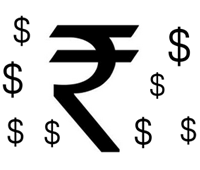Government bonds posted their biggest weekly gain in four-and-a-half years, aided by the Reserve Bank of India's moves to support the rupee and liquidity in the market.
The benchmark 10-year bond yield fell 62 basis points over the week, the sharpest since January 16, 2009.
The 2023 bonds closed at 8.26 per cent, up 3 bps on the day but off the day's highs of 8.34 per cent.
"This is not a fundamental rally because it is driven by the central bank's moves and as long as that support remains, yields should not go up," said A. Prasanna, an economist with ICICI Securities Primary Dealership Ltd.
"The RBI has given the market an opening to bet on further OMO auctions," he said.
Earlier in the day, the Reserve Bank of India conducted its first purchase through open market operation (OMO) in five weeks. The move was part of a clutch of measures announced to prop up the rupee.
Bond yields fell as much as 69 bps on August 21 after the OMO announcement in the previous day, accounting for a major part of the drop this week.
The central bank said it would buy 80 billion rupees of bonds through OMO, including the 10-year benchmark 2023 bonds. The outcome of the auction was being awaited until market close.
Yields rose as much as 3 bps after the RBI announced high cut-off yields for the short-end bonds at its weekly auction of 150 billion rupees.
Earlier in the day, bonds were supported after data showed foreign institutional investors (FIIs) turned net buyers of Indian debt after three sessions. FIIs bought debt worth $267 million on August 21, data from the stock market regulator showed on Thursday.
Traders said debt redemptions in September are higher than total sales, and coupled with the redemption of the cash management bills on September 17, there will be a net infusion of cash into the banking system, adding to the positive sentiment for bonds.
In the overnight indexed swap market, the benchmark five-year rate closed down 53 bps on the week at 8.41 per cent, its biggest weekly fall since mid-September 2008. The one-year rate ended down 51 bps on the week at 9.45 per cent, its biggest weekly drop since early January 2009.
The five-year and one-year rates had closed at 8.48 per cent and 9.58 per cent on Thursday, respectively.
Rupee posts biggest single-day gain in nearly a year
The rupee rose 2.1 per cent on Friday, its biggest jump in nearly a year, as equities posted strong gains for a second session and the RBI was suspected to have sold dollars heavily late in the session.
However, the partially convertible rupee registered its second weekly loss, as investors fretted over fears of how the country will fund its large current account deficit as the U.S. Federal Reserve is expected to begin tapering its monetary stimulus.
The rupee hit a series of record lows in the week, falling as much as 65.56 to a dollar on Thursday, making its Asia's worst performer so far in 2013.
Policymakers stepped in late Thursday to calm markets.
Finance Minister Palaniappan Chidambaram said that the rupee was "undervalued" and the current account deficit could be smaller than the previously estimated $70 billion.
Reserve Bank of India governor Duvvuri Subbarao also chimed in, saying that the central bank would continue with its cash tightening steps until the rupee stabilises.
"We are looking for a pullback in the USD/INR to 63.50-63.60 in the next two days (sessions) due to genuine exhaustion and positive U.S. equities," said Dhirem Sarin, chief technical strategist, Asia-Pacific, at Barclays in Singapore.
Strong local stocks, which rose 1.1 per cent on Friday, and dollar selling by corporates helped the rupee.
The rupee has been trading in the oversold zone with its 14-day relative strength index hitting 82.8 due to six straight day of losses as of Thursday's close, implying increasing likelihood of the currency recovering some of its recent losses in short term, technical analysts say. Anything above 70 is considered oversold territory.
The rupee strengthened to 63.20/21 to a dollar as against 64.55/56 Thursday close, its biggest single day gain since Sept, 2012.
However, many foreign banks and brokerages continue to remain bearish on the rupee. Dealers said heavy central bank intervention in late trades pushed the rupee up.
Macquarie in a note said that weak investor sentiment meant that the rupee may weaken to 67-70 to the dollar in three months.
Indian equities, which have been relatively resilient to outflows, have seen $700 million of money going out in the five sessions to Thursday.
Foreign funds were net sellers of nearly $200 million in Indian equities on Thursday, a day when the benchmark index gained 2.3 per cent.
The 1-month offshore non-deliverable forward contract was quoted at 63.83 compared to the onshore one-month forward of 63.73.
In the currency futures market INRFUTURES, the most-traded near-month dollar/rupee contracts on the National Stock Exchange, the MCX-SX and the United Stock Exchange all closed at around 63.94 with a total traded volume of $3.4 billion.






